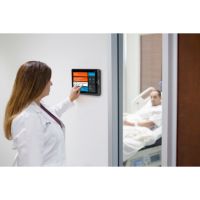Masimo today announced the results of a study published in Pneumonia in which independent researchers in New Delhi, India, investigated the accuracy of Masimo RRp® on pediatric patients with the Rad-G™ Pulse Oximeter by comparing it to clinician-determined values while performing routine assessment of children admitted to outpatient and emergency departments.1 RRp provides respiration rate determined from the photoplethysmograph used in pulse oximetry.
This press release features multimedia. View the full release here
Noting the high incidence of childhood pneumonia in many parts of the world, the inclusion of oxygen saturation (SpO2) and respiratory rate measurement in pneumonia screening guidelines, and the scarcity of medical equipment and variability in medical training in many low-resource settings, Dr. Alwadhi and colleagues sought to determine whether a “multi-modal” pulse oximeter, Masimo Rad-G, could also accurately measure respiration rate—supporting future applications for a more streamlined and reliable approach to pneumonia screening case management. Rad-G uses a single Masimo SET® pulse oximetry sensor to measure both SpO2 and RRp, as well as pulse rate (PR), perfusion index (Pi), and pleth variability index (PVi®).
In this particular study, the researchers used Rad-G, alongside traditional pediatrician assessment, to measure the respiration rate of 97 children (aged 2 to 59 months) admitted to the outpatient and emergency departments at Kalawati Saran Hospital in New Delhi, over 2 weeks. They then analyzed the level of agreement between plethysmography-based respiration rate (RRp) and the clinicians’ assessment of respiration rate.
The researchers found that RRp and the control respiration rate measurement method showed “significant strong association (97%)” (p < 0.001), and that “values obtained either from pulse oximeter or by pediatrician (gold standard) are very close to each other.” For assessing fast breathing (defined as ≥ 50 breaths per minute (bpm) for infants 2 to 12 months and ≥ 40 bpm for children older than 12 months), RRp had high sensitivity (95%) and specificity (94%), with 95% accuracy. Based on these findings, the authors explained, “The sensitivity analysis, in addition, points to the reliability of the device in correctly identifying fast breathing, a major symptom of the disease [pneumonia], in 95% of the cases.” They also noted that Rad-G “allows for significantly integrated results of RR and SpO2 with high sensitivity and accuracy in health care settings, as well as the possibility of rapid detection.”
The researchers concluded, “There is a high degree of agreement between pleth-based RR using a [pulse oximetry device] and physician measured RR, indicating that the former provides reliable and accurate measurement. Current diagnosis and management of pneumonia in primary health care is based on variably trained health providers despite IMCI [Integrated Management for Childhood Illness] guidelines. The use of pulse oximeters, also recommended by the WHO, which can provide reliable measurement, would streamline pneumonia case management in these settings. The current study provides evidence of the reliability of pulse oximeter[s].”
Masimo RRp is CE marked and U.S. FDA 510(k) cleared. Rad-G is currently CE marked and the U.S. FDA 510(k) clearance is pending.
Latest Articles
WHO, Pneumonia, Masimo, Rad-G™ Pulse Oximeter, pulse oximetry, Masimo RRp®, Kalawati Saran, Kalawati Saran Hospita, Kalawati Saran Hospital, Dr. Alwadhi, Integrated Management for Childhood Illness, IMCI
Masimo today announced the results of a study published in Pneumonia in which independent researchers in New Delhi, India, investigated the accuracy of Masimo RRp® on pediatric patients with the Rad-G™ Pulse Oximeter by comparing it to clinician-determine



























